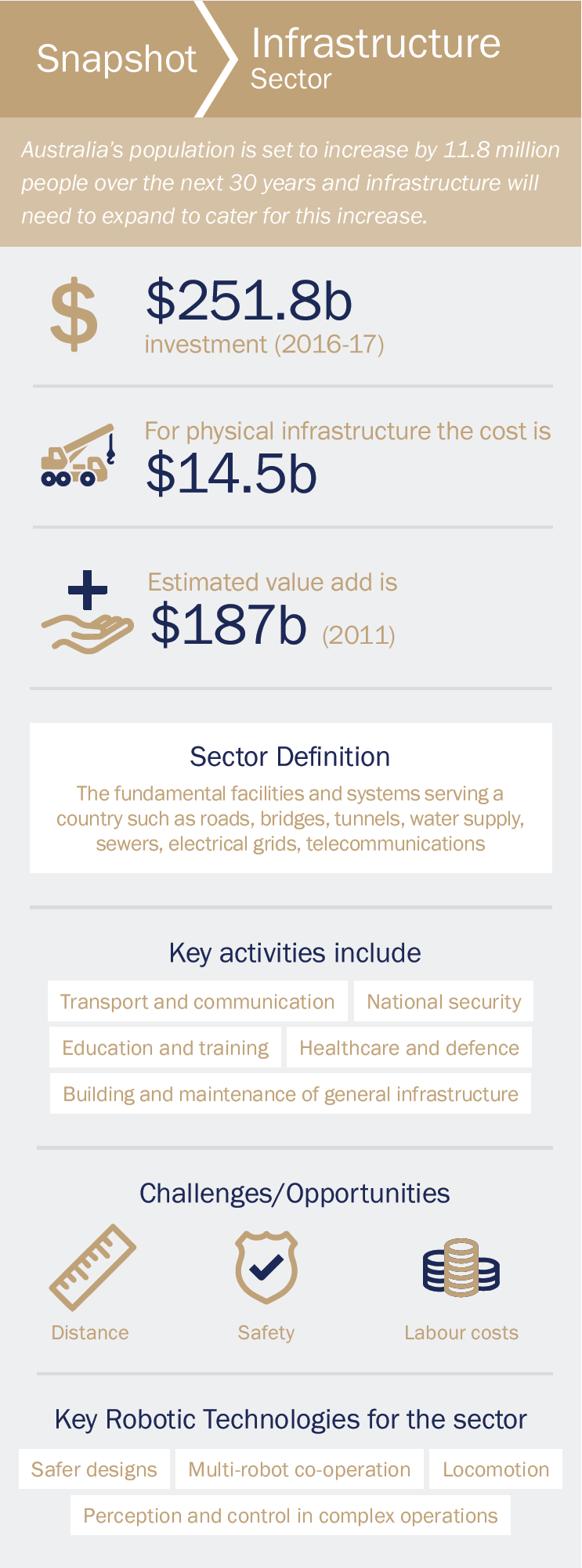
Robotics and infrastructure today
Infrastructure robotics is a key transformative technology that can revolutionise Australia’s economy in the construction and resource sectors. It will lead to a new era of smart resource and infrastructure management, positioning Australia’s global competitiveness in this area. Currently the construction and resources sectors (see Chapters 4 & 7) contribute more than 15 per cent of Australia’s GDP each year. The Australian government has committed significant physical infrastructure investment (more than $AU70 billion from 2013-2021), as part of the national economic plan for jobs and growth [PC17]. This is primarily to meet significant population growth, as by 2031 more than 30 million people will call Australia home [CR1] and 75 per cent of this growth will occur in cities where infrastructure is already close to capacity [EY-INF16].
While this investment growth provides further opportunities to grow jobs and domestic businesses in conventional markets, it creates extra demands on government and local councils to maintain additional infrastructure over large land masses. Australia is also renowned for building and maintaining world-class infrastructure services. This investment, combined with a surge in the Asian middle-class (one of Australia’s important trading partners), provides an unprecedented opportunity for Australian businesses to capitalise on global infrastructure spending on buildings, roads, bridges, water, ports, energy and telecommunications infrastructure. Hence any opportunities to build on Australia’s existing industry and research strengths to capitalise on these opportunities would be highly valuable.
Advanced robotics in infrastructure could achieve these outcomes. Increasing automation in this area will enable Australia to be more competitive globally by fundamentally changing how infrastructure is built, managed, maintained and decommissioned. With governments and industry required to do more with less, intelligent robotics and physical automation is a cost-effective way of addressing global maintenance and construction issues. This is especially the case when building and maintaining (especially ageing) infrastructure, or difficult-to-access infrastructure over large geographic areas, while removing humans from dangerous working environments. In addition, governments globally will be facing greater challenges in maintaining and constructing assets due to impacts of climate change, extreme weather conditions and terrorism related incidents. Hence intelligent infrastructure solutions will be required to gather and provide crucial information more rapidly and cost-effectively to respond to natural disasters or terrorism related incidents.
Overall, Australian businesses and the community rely heavily on a wide range of supporting infrastructure to ensure a high standard of living and the success and prosperity of the economies dependent on this essential infrastructure. To ensure Australia can maintain our high living standard, with rapid population growth, we need to transition the construction, inspection, maintenance, and decommissioning industries towards advanced robotic technologies.

